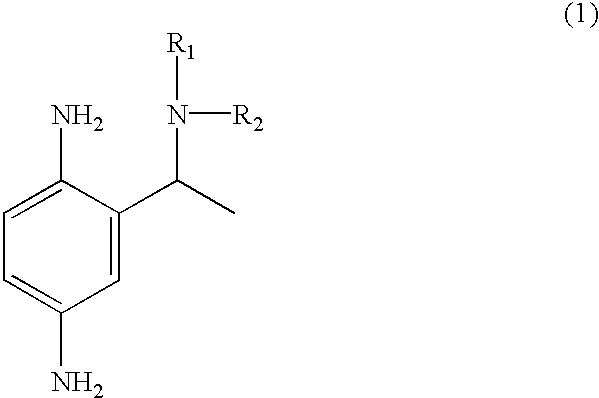Primary intermediates for oxidative coloration of hair
a technology of oxidative coloration and intermediates, which is applied in the preparation of amino compounds, hair cosmetics, dyeing processes, etc., can solve the problems of p-phenylenediamine use questioned, and the proposed replacements of p-phenylenediamine have not been entirely satisfactory
- Summary
- Abstract
- Description
- Claims
- Application Information
AI Technical Summary
Benefits of technology
Problems solved by technology
Method used
Image
Examples
synthesis example 2
Synthesis of 2-(1-methylamino-ethyl)-benzene-1,4-diamine (7): To a solution of triethylamine (2.0 g, 20 mmol) in absolute ethanol (15 mL) were added methylamine hydrochloride (1.35 g, 20 mmol), titanium (IV) isopropoxide (5.7 g, 20 mmol), and (2) (1.80 g, 10 mmol). The reaction mixture was stirred at room temperature for 24 h and quenched with aqueous ammonium hydroxide (2N, 30 mL), filtered and washed dichloromethane. The organic layer was dried over sodium sulfate, filtered and evaporated to afford (6) (1.2 g, 61.5% yield). Catalytic hydrogenation of (6) (1.2 g, 6.1 mmol) with 10% Pd / C (0.24 g) in ethyl acetate (50 mL) at 60 psi hydrogen for 2.5 h afforded (7) (740 mg, 72.4% yield). ##STR5##
synthesis examples 3 to 11
Employing the appropriate R.sub.1 R.sub.2 NH reagent, reducing agent and 2-amino-5-nitro-acetophenone in the synthesis procedure described, the following benzene-1,4-diamine derivative compounds of formula (1) of this invention can be prepared:
2-(1-phenylamino-ethyl)-benzene-1,4-diamine;
2-(1-piperidin-1-yl-ethyl)-benzene-1,4-diamine;
2-(1-benzylamino-ethyl)-benzene-1,4-diamine;
2-[1-(4-methoxy)-phenylamino-ethyl]-benzene-1,4-diamine;
2-(1-dimethylamino-ethyl)-benzene-1,4-diamine;
2-(1-morpholin-4-yl-ethyl)-benzene-1,4-diamine;
2-(1-imadazolin-1-yl-ethyl)-benzene-1,4-diamine;
2-[1-(4-methoxy)-benzylamino-ethyl]-benzene-1,4-diamine; and
2-(1-hydroxyethylamino-ethyl)-benzene-1,4-diamine.
As used herein, the term "hair dyeing composition" (also synonymously referred to herein as the hair dye composition, the hair coloring composition, or the hair dye lotion) refers to the composition containing oxidation dyes, including the novel compounds described herein, prior to admixture with the developer...
example 1
Dyeing Example 1
The following composition shown in Table 1 can be used for dyeing Piedmont hair. 100 g of the dyeing composition is mixed with 100 g 20 volume hydrogen peroxide. The resulting mixture is applied to the hair and permitted to remain in contact with the hair for 30 minutes. The dyed hair is then shampooed, rinsed with water and dried. The ranges of ingredients set out in Table 1 are illustrative of useful concentrations of the recited materials in a hair dye product.
PUM
| Property | Measurement | Unit |
|---|---|---|
| temperature | aaaaa | aaaaa |
| weight percent | aaaaa | aaaaa |
| weight percent | aaaaa | aaaaa |
Abstract
Description
Claims
Application Information
 Login to View More
Login to View More - R&D
- Intellectual Property
- Life Sciences
- Materials
- Tech Scout
- Unparalleled Data Quality
- Higher Quality Content
- 60% Fewer Hallucinations
Browse by: Latest US Patents, China's latest patents, Technical Efficacy Thesaurus, Application Domain, Technology Topic, Popular Technical Reports.
© 2025 PatSnap. All rights reserved.Legal|Privacy policy|Modern Slavery Act Transparency Statement|Sitemap|About US| Contact US: help@patsnap.com



